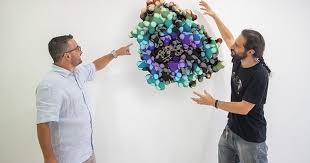Source:
‘Big Data’ has become a staple of scientific endeavour. The phrase crops up repeatedly in common parlance. It has become a buzzword synonymous with scientific effort, experimental complexity and data reliability. This is because the field of ‘Big Data’ offers ways how to deal with large datasets often originating from different experiments.
For example, an experiment to sequence your DNA may generate over 200GB of data. That is the size of two full-length 4K movies!
Big Data increases the robustness of any findings and reduces the odds of a result being only due to chance.
In molecular biology, if a scientific result is supported by various sources of data, such as DNA, protein and other molecular research, then it would be expected to provide a better overall understanding of the natural phenomena under study.
However, to generate and analyse such ‘Big Data’, scientists are required to train in both wet-lab and dry-lab techniques. ‘Wet-lab’ scientists perform research on chemical and biological samples of various origins, including patients. ‘Dry-lab’ scientists mine the large datasets generated from a multitude of experiments computationally. They combine all the elements together to identify trends, create models and provide unique insight that no single source of data can achieve.
This kind of research integration has many applications. Networks can be built to understand the relationships between genes or proteins. Libraries of synthesised compounds can be screened in search of potential drugs. Diagnostic biomarkers may be identified by combining DNA sequencing and protein datasets. On a large scale this is beneficial to patients in the form of earlier diagnosis, personalised treatment and improved outcome.
Modern biomedical research labs rarely conduct purely wet- or dry-research. The scientist of the 21st century needs to be skilled in both types of research. Thus, prospective biomedical students are encouraged to try their hand at both dry- and wet-lab techniques. This enables them to find their place in the research community of the future, doing research that they enjoy.
The University of Malta offers several courses which train students in dry- and wet-lab skills and research.
Jean Paul Ebejer is the coordinator for the Master’s in Bioinformatics programme and performs research in bioinformatics and computer-aided drug design. Byron Baron is involved in the BSc for medical biochemistry and heads research in methylation proteomic analysis on cancer.
Both lecture and research at the Centre for Molecular Medicine and Biobanking of the University of Malta.
Sound bites
• A groundbreaking study is the first to analyse the relationship between group behaviours, group type, group dynamics, and kinship of beluga whales in 10 locations across the Arctic. Results show that not only do beluga whales regularly interact with close kin, including close maternal kin, they also frequently associate with more distantly related and unrelated individuals. Findings will improve the understanding of why some species are social, how individuals learn from group members and how animal cultures emerge.
• Dinosaurs and flying pterosaurs may be known for their remarkable size, but a newly described species from Madagascar that lived around 237 million years ago suggests that they originated from extremely small ancestors. The fossil reptile, named Kongonaphon kely, or ‘tiny bug slayer’, would have stood just 10 centimetres tall. The description and analysis of this fossil and its relatives, published in the journal Proceedings of the National Academy of Sciences, may help explain the origins of flight in pterosaurs, the presence of ‘fuzz’ on the skin of both pterosaurs and dinosaurs, and other questions about these charismatic animals.
For more soundbites listen to Radio Mocha every Saturday at 7.30pm on Radju Malta and the following Monday at 9pm on Radju Malta 2.
Did you know
• The National Gallery in London was only shut for two days during World War II, ironically during VE Day celebrations in May 1945.
• You are not imagining it ‒ summer heat really does make people crankier.
• The average garden snail has over 14,000 teeth.
• Leonardo da Vinci was notorious for missing deadlines. Pope Leo X is reported to have said: “This man will never accomplish anything, he thinks of the end before the beginning.”
• Eating too many carrots, pumpkin or citrus fruits can result in ‘carotenosis’, where your skin turns orange.
• There are more trees on Earth than there are stars in the Milky Way. Until now.
